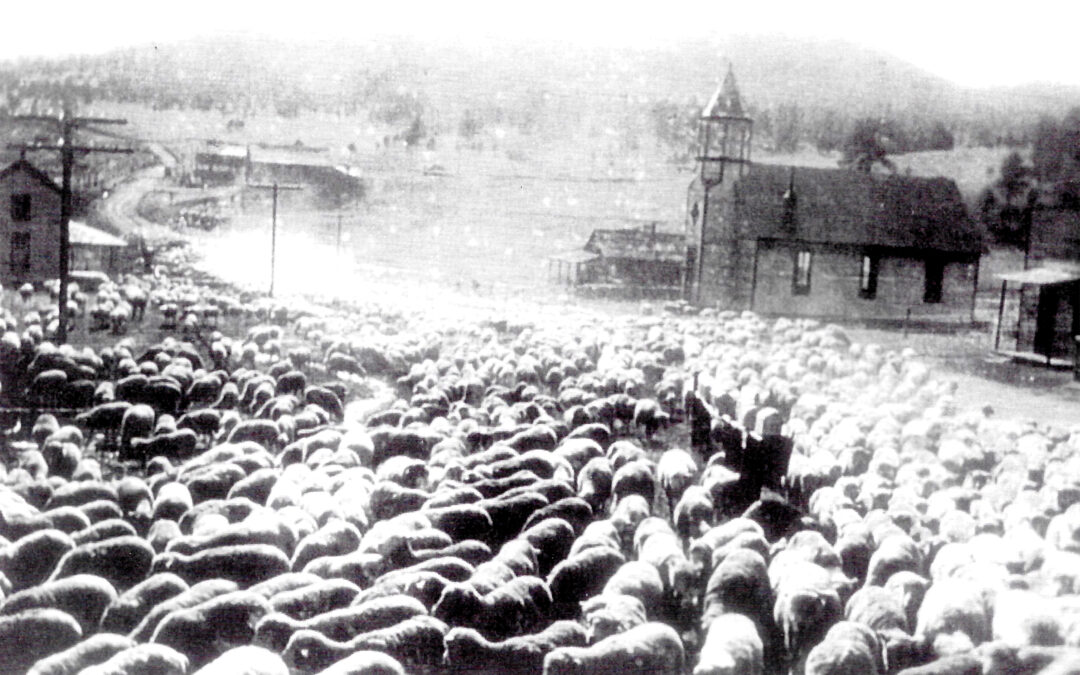((Above photo–Sheep herded through Shaffer’s Crossing make their way toward the stock yards in Denver in 1920. Photo courtesy of Peggy Stock. This article awarded 1st place in the Jefferson County Historical Writers’ Contest))
To the driver passing by, Shaffer’s Crossing on Highway 285 may hardly seem worth a second glance. There is a sign along the road, several old buildings, an exercise gym and a very popular fishing pond. Beyond that, most people may not know about the bustling little community that existed here at the turn of the last century. It wasn’t an easy way of life, but there were businesses and homes, dances and weddings, churches and cattle ranches, births and deaths.
This peaceful mountain valley had as many as three names before “Shaffer’s Crossing” finally stuck. Harold Warren says it was common for rural places to be named for a school, a post office or stage stop.
The first mention of a building in this area in the 1860s was the wayside stop St. Louis House and the Omaha House. The place was reported as a ranch and post office called Willowville by 1880.
Shaffer’s Crossing was next called Urmston. In 1902, the town had a grocery, tobacco store and blacksmith. The name of Belleville perhaps predated Willowville.

Store and home of Samuel and Sarah Jane Shaffer, known as Shaffer’s Crossing Road Ranch. It was located on the hill south of the creek and east of the road. Photo courtesy of Hiwan Homestead Museum
Samuel A. Shaffer moved his family from Wyoming in 1902 and started a horse ranch the same year. Along with trading horses, the family business also included farming, threshing, milling and cutting railroad ties. Eventually they ran the store and dance hall. The name Shaffer’s Crossing came about because it marked the area on Shaffer’s property where the old stagecoach route crossed Elk Creek. When Shaffer decided he wanted a town on this spot, he gave away parcels of land to “anyone who would build a house.”
The Shaffer house was “L”-shaped with the grocery and general merchandise store in the long part of the “L”, which no longer exists. It sat just over the hill behind the “octagonal” barn. Shaffer’s store was known to have “everything from a needle to a threshing machine.”
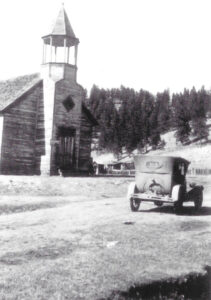
Methodist Episcopal Church–early 1930’s; built in 1881. Photo courtesy of Harold Warren.
The beautiful Methodist Episcopal Church was built in 1881. Long time residents Rudy and May Long were the last couple to be married there with five hundred people attending. Years later it was discovered that the church had been built on Shaffer’s property. A clause in their deed allowed the church to remain on their land until meetings were no longer held there. It would revert back to the owners. When the Shaffer heirs had sold the property to Virgil Eden and the church was going to be torn down, May Long’s grandmother was the last living trustee and asked that the Bible and Christ’s picture be retrieved for her. Later, when the Conifer Community Church organized, May returned bible and picture to the Church with the agreement that the two items stay with the church for as long as it exists.
The Long family also owned the beautiful historical Clifton House on the east side of 285, across from the Long Garage. It was home to Rudy Long’s grandmother, mother and father and Rudy and his siblings. It boasted of being ‘well built, being one of the first to be lathed and plastered’ and was also the first to have a bathtub, although water was carried to it. It housed the first telephone station in the area for 30 years until 1921. Charlie Long, Rudy’s father, worked for the telephone company and helped string the first line from Denver to Leadville. Visitors constantly arrived at their front door to use the only available line into Denver.
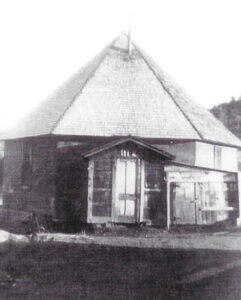
Photo taken in 1922 shows the Grange Hall where the school and Fire Department met. It still stands today. It is also known as the octagonal building or the Urmston School. Photo courtesy of Peggy Stock.
Old timers remember the wonderful dances held at Shaffer’s Crossing. People would ride up in wagons and dance all night. Leon and Madge Legault, whose families homesteaded in Pleasant Park, recalled the night they won a prize for their waltz. Rudy and May Long reminisced about walking to Shaffer’s Crossing on Saturday nights and dancing in the Urmston Grange Hall, which still stands in the meadow today. Often there was more dancing after church, wrapping up just in time for dinner.
Joe Hill, the mail carrier out of Pine, also talked fondly of the dances at Shaffer’s Crossing. “They Had a cupola building at Shaffer’s Crossing. I bet I danced a thousand miles around that thing, just round and round. The Grange used to meet there. We formed a little club, I don’t know what you’d call it, and charged for our dances and bought a player piano and that furnished our music…then we had two musicians that came to the country. First was Isham Jones.”
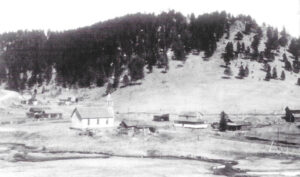
Shaffer’s Crossing, early 1930’s. Photo courtesy of Peggy Stock.
Isham Jones, the famous musician and jazz band leader of Jones’ Juniors, moved to Shaffer’s Crossing in the late 1930’s after retiring from touring and recording in 1936. His ranch was at the end of Parker Avenue and it was here that he composed the popular hit tune, “It Had To Be You.” Rumor has it that Woody Herman and many other jazz greats played at the Crossing as well. Art Castle built a place at Shaffer’s Crossing and his plan was to raise chickens. Castle’s theme song was “Castle’s in the Air.” The building was not quite finished when it caught fire and put an end to his dream.
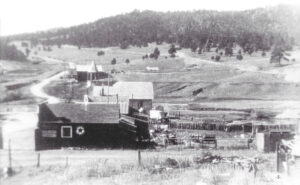
Shaffer’s Crossing in 1926 as seen from Highway 285. Photo courtesy of Peggy Stock.
The name Shaffer’s Crossing,” was submitted to the clerk at the Colorado History Museum but produces nothing more than the phrase: “…a favorite rendezvous for stage robbers and other outlaws.” While that sounds exciting, very little evidence would back up such claims. Harold Warren says that people didn’t have a whole lot back then that could be stolen, and a lot of the stories we hear tend to be exaggeration. The only documented outlaw episode to be found involved Charlie Long of the Clifton House. The Denver-Leadville stage was held up one day by a bandit in the Turkey Creek area. The thief made off with all the money and a horse and hightailed it from the hold-up spot to Charlie Long’s barn. Charlie was milking when the robber arrived with his tuckered horse. He jumped off, grabbed another one without Charlie’s permission and was off again. The story goes that the crook hid the treasure somewhere in the Elk Creek area of the mountains. No one has ever claimed to have found it, so it may still be there.
The history of Shaffer’s Crossing wouldn’t be complete without also telling its stories of tragedy. One such tale remains a mystery to this day: the murder of Mr. and Mrs. Robert Standering. Harold Warren recalls that on a Sunday evening in November 1884, “Mr. Standering answered a knock on the door of the cabin and was met with a blast from a shotgun loaded with slugs that hit him squarely in the chest.” Death was instantaneous. Mrs. Standering had already gone to bed but tried to get up when she heard the gun. “As she arose, the assassin placed the muzzle of the shotgun against her breast and fired, killing her instantly.” And if that wasn’t enough, “The assassin fired a bullet from a .44 caliber pistol into the woman’s head and three more shots into Mr. Standering’s back just to make sure they were dead.”
John Carruthers, a homesteader and neighbor of the Standerings, was feuding with the couple at the time, so he was considered a suspect. However, he was soon cleared of the charges by proving that he was at a wedding in Denver, and had also broke his leg in an accident the same night. Another man named Burke, who lived near Pine, was also arrested in connection with the 1884 murder but was later released.
It would be 1907 before the next killing occurred in the tranquil mountain town. This famous altercation took place where the trout pond now stands on the north side of Highway 285 and the Shaffer name would be involved. In August of that year, the Colorado Transcript reported that “25-year-old Bert Shaffer killed a timberman named Grant McQuery in self-defense.” McQuery apparently accused the Shaffer boys, Bert and Charlie, of stealing some of his railroad ties which they denied. After calling Bert a ‘vile name’ and ‘striking him with a piece of iron pipe,’ McQuery throws a ‘heavy stone at the boy’, striking him in the jaw. Bert grabs his rifle and shoots and kills McQuery instantly. He was acquitted at his trial held in Golden, but dad sent both boys away to Wyoming to prevent further feuds with the McQuerys.
Another Shaffer soon would become the area’s mailman…or should I say mail person? Lila Shafer was born Claudia Daisy Peckham in 1882. She married at a young age to escape an abusive stepmother; but the man she married was even meaner when he drank. She left, changed her name, and married Rollo Shaffer, one of Samuel’s sons, in 1914. From then on she was Lila D. Shaffer. Her job delivering mail began when mail carrier Robert E. Kinney was called into service during World War I. When no man was available for the position, she took over. Except when she was sick once during the flu epidemic, she never missed a trip.
Postal regulations in those days didn’t allow for delivery of the mail by automobile, but Mrs. Shaffer used their horseless carriage anyway. She decided to give up the job when it became too much for her.
Joseph A. Hill took over the route as a temporary carrier and received permanent status in 1920. The route was then 21.5 miles long and served 48 families. It grew to 51.9 miles and 200 families when he retired in 1967. The Post office authorized the use of automobiles in 1924. And Joe delivered more than just mail. His wife, Olive, recalled he ‘supplied groceries on occasion, delivered urgent messages and shared a warm friendship with his rural customers.’
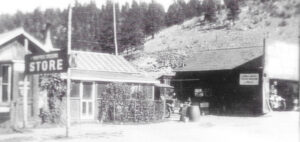
Grocery store and garage owned by George and May Brunskill. Photo by Peggy Stock.
Some of the buildings and homes in Shaffer’s Crossing disappeared over the years because of progress. Specifically, roads being built in the area. Harold Warren says some buildings had to be torn down because they weren’t built on foundations. One home burned to the ground along with the family’s schoolbooks that their son kept at home when he was ill with spinal meningitis. And on April 1, 1965, an historic building and connecting businesses burned ‘practically to the ground.” The Fairplay Flume reported that the structure caught fire at 5:20AM. The custodian immediately notified the Elk Creek Fire Department. They had 27 men respond within minutes. It only took an hour to control, but the building was a total loss. At one time or another, this building had been a garage, a store, a bar and a café. Once it was even owned briefly by Isham Jones.
The years took their toll on the area and soon what had existed was relegated to “ghost town’ status. But in February,1974, a reserve officer with the Jefferson County Sheriff’s Office brought the Shaffer’s Crossing name back to the headlines by claiming to have made a half dozen sightings of a strange object hovering over what he guessed to be Shaffer’s Crossing! Joseph Cope was not a UFO fanatic. Far from it. As he always did, he was also monitoring the Sheriff’s channel on his radio scanner on this particular Saturday night. The dispatcher gave an assignment to Deputy Ken Fitzpatrick to check out a report from a mountain resident who said he was watching strange lights in the sky over the Pine-Shaffer’s Crossing area. Not only did Fitzpatrick see the object as he drove along Highway 285 toward Conifer, so did Joe Cope who had taken out his binoculars. The description was of an object, some 8,000 to 10,000 feet above the mountains which colored from amber to white and back to amber. Within this glow were red, sometimes green, and blue lights with no apparent blinking pattern. Cope said it hovered 30 to 45 minutes over what he thought was Shaffer’s Crossing, faded for half an hour, then reappeared approximately above Tiny Town. About 3AM it was gone. Two nights later, at 3:45AM, Cope woke up, looked out the window and saw the glowing object again. The deputy dispatched to the Conifer area saw nothing, but two deputies went to Cope’s Lakehurst home, and with his son they all watched the object until just before daybreak when it faded away. There was never an explanation for the strange lights and object; but Lt. Bill Flint of the Jefferson County Sheriff’s Office said Cope and the deputies who were with Cope that night made three triangulations of flight pattern in the Pine Junction-Shaffer’s Crossing area to the Conifer-Tiny Town area and then closer to the plains over the Mt. Morrison Area and concluded that “On a clear night, there was no possibility of light-cloud reaction,” Flint adds. Will we ever know?
These days, kids and adults sit at the popular trout pond on the north side of Highway 285 and giggle and laugh as they catch what they imagine to be the biggest fish ever! Or was that a giggle from a moment in time when kids would try to peak into the windows of the Grange Hall to see who’s dancing with whom? The mailman drives up in his clean, boxy white truck with an armload of stuff. Or is that the crunch of a buggy wheel from a moment in time when 25 mailboxes sat at Shaffer’s Crossing waiting and hoping to be filled? A telephone clicks as its call is instantaneously put through to its destination. Or is that the click of a party line from when neighbors would hope to catch the latest gossip of the area?
It’s still there…and to the blinded eye would Shaffer’s Crossing hardly seem worth a second glance.
# # #
Warren, Harold. Interview
Bentley, Margaret V. The Upper Side of the Pie Crust
Crain, Mary Helen. “Historic Clifton House”, Canyon Courier.
Karber, Jennifer. “Shaffer’s Crossing Has Interesting History”, Courier Chronicles.
Warren, Harold. Bits and Pieces of History Along the 285 Corridor
“Fire at Shaffer’s Crossing”, Fairplay Flume.
“There’s Something Over the Foothills—But What?”, Lakewood Sentinel.

